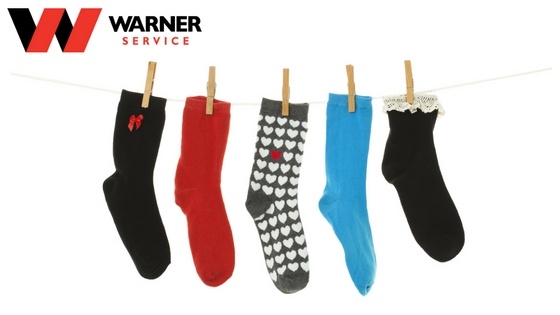
In honor of Warner Service’s new product, the Laundry Pro, we’re giving you a few fun facts about laundry machines, from their humble beginnings as a hand-powered appliance to a final say about where your socks go -- and it’s not where you think:
- According to The Fact Site, washing machines began as hand-powered appliances in the 1800s. After that, steam-powered commercial washers appeared in the 1850s, but residential washing machines remained hand-powered until the early 1900s. The electrical-powered washer that we know today has existed since 1908.
- Houz Buzz reports that inventor James Dyson says 15 minutes of hand-washing is more effective at cleaning clothes than an hour of machine washing due to the ability for hands to flex fabrics, which machines cannot do.
- “The Automatic Electric Washer Company [from Newton, Iowa] and Hurley Machine Corporation [from Chicago] began selling electric washers in 1907, while Maytag [from Gaithersburg, Md.] offered an electric wringer washer in 1911. In 1947, Bendix [from Hollywood, Calif.] offered the first fully automatic washing machine, and by 1953, spin-dry machines overtook the wringer types in popularity,” according to Encyclopedia.com.
- In 2006, Dr. Lucas Emil set out on a study to determine a correlation between DNA and carelessness. He used washing clothes as a test and found that more than 87 percent of participants reported that they had lost socks. However, an astounding 93 percent of the students had actually gained socks. He coined his results as the Lost Sock Fallacy. Read more about it in The Huffington Post.
- The average family does 8 to 10 loads of laundry per week, according to Rental Banjara, an India-based appliance rental company. That’s about 50 pounds of laundry, which contains an average of 16 different items.
- In terms of green laundry, front-loading machines are more efficient than top-loading machines.
- Almost a quarter of all the water used in the United States is by laundry machines.
- Many parts of a washing machine are fabricated from sheet steel that is typically coated with zinc to improve rust resistance.
- Most washer tubs are manufactured with stainless steel or enameling iron, coated with porcelain. Whirlpool [from Benton Harbor, Mich.] is the exception, as they use plastic for the outer wash tub instead of enameling iron.
- All laundry machine parts purchased from outside manufacturers are tested before use. For example:
- All transmissions are automatically tested for operation, noise, and vibration.
- All pumps are leak-tested using air.
- All painted parts are visually inspected for defects.
- Daily samples are put in detergent, bleach, and steam baths for corrosion testing.
- Once completely assembled, the machine is filled with water and tested for noise, vibration, visual defects, and functional controls and mechanisms.
- After packaging, certain units go through transportation simulation conditions to test the cartoning process.
- One of the first laundry products was detergent, created in Germany using certain synthetic surfactants. It was in response to the shortage of regular soap shortly after World War I.
- More than 90 percent of washing machines around the world are used by women. In fact, eHow states that L'Ossovatore Romano, the Vatican’s newspaper, said the washer had more to do with women's liberation than birth control or the right to work. A University of Montreal study agreed, pointing out that home appliances freed women's time, enabling them to enter the workforce.
- The average load takes about an hour and a half to be washed and dried.
Who knew that the history and statistics behind household appliances could be so entertaining? Whether it was about the Lost Sock Fallacy or how washing machines helped women's rights, we hope you learned something new.
For more information about washing machines, download Warner Service’s how-to for organically cleaning your laundry machine:


